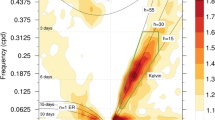Abstract
This note describes a numerically stable version of the improved Mellor–Yamada (M–Y) Level-3 model proposed by Nakanishi and Niino [Nakanishi, M. and Niino, H.: 2004, Boundary-Layer Meteorol. 112, 1–31] and demonstrates its application to a regional prediction of advection fog. In order to ensure the realizability for the improved M–Y Level-3 model and its numerical stability, restrictions are imposed on computing stability functions, on L/q, the temperature and water-content variances, and their covariance, where L is the master length scale and q 2/2 the turbulent kinetic energy per unit mass. The model with these restrictions predicts vertical profiles of mean quantities such as temperature that are in good agreement with those obtained from large-eddy simulation of a radiation fog. In a regional prediction, it also reasonably reproduces the satellite-observed horizontal distribution of an advection fog.
Similar content being viewed by others
References
Galperin B., Kantha L.H., Hassid S., and Rosati A. (1988). ‘A Quasi-Equilibrium Turbulent Energy Model for Geophysical Flows’. J. Atmos. Sci 45:55–62
Gerrity J.P., Black T.L., and Treadon R.E. (1994). ‘The Numerical Solution of the Mellor–Yamada Level 2.5 Turbulent Kinetic Energy Equation in the Eta Model’. Mon. Wea. Rev. 122:1640–1646
Helfand H.M. and Labraga J.C. (1988). ‘Design of a Nonsingular Level 2.5 Second-Order Closure Model for the Prediction of Atmospheric Turbulence’. J. Atmos. Sci 45:113–132
Janjić, Z. I.: 2001, Nonsingular Implementation of the Mellor–Yamada Level 2.5 Scheme in the NCEP Meso Model, Office Note No. 437, National Centers for Environmental Prediction, 61 pp.
Japan Meteorological Agency.: 2002, Outline of the Operational Numerical Weather Prediction at the Japan Meteorological Agency, Appendix to the WMO Numerical Weather Prediction Progress Report, Japan Meteorological Agency, Tokyo, 158 pp.
Kantha L.H. and Clayson C.A. (1994). ‘An Improved Mixed Layer Model for Geophysical Applications’. J. Geophys. Res. 99(C12):25235–25266
Katayama A. (1972). A Simplified Scheme for Computing Radiative Transfer in the Troposphere, Numerical Simulation of Weather and Climate. Technical Report No. 6, University of California, Los Angeles, 77 pp.
Klemp J.B. and Durran D.R. (1983). ‘An Upper Boundary Condition Permitting Internal Gravity Wave Radiation in Numerical Mesoscale Models’. Mon. Wea. Rev. 111:430–444
Mellor G.L. and Yamada T. (1982). ‘Development of a Turbulence Closure Model for Geophysical Fluid Problems’, Rev. Geophys. Space Phys. 20:851–875
Musson-Genon L. (1987). ‘Numerical Simulation of a Fog Event with a One-Dimensional Boundary Layer Model’. Mon. Wea. Rev. 115:592–607
Nakanishi M. (2000). ‘Large-Eddy Simulation of Radiation Fog’. Boundary-Layer Meteorol 94:461–493
Nakanishi M. (2001). ‘Improvement of the Mellor–Yamada Turbulence Closure Model Based on Large-Eddy Simulation Data’. Boundary-Layer Meteorol 99:349–378
Nakanishi M. (2002). ‘A Lateral Boundary Condition Suitable for the One-Way Nesting Scheme’. Tenki 49:117–128 (in Japanese).
Nakanishi M. and Niino H. (2004). ‘An Improved Mellor–Yamada Level-3 Model with Condensation Physics: Its Design and Verification’. Boundary-Layer Meteorol 112:1–31
Smagorinsky J., Manabe S., and Holloway J.L. (1965). ‘Numerical Results from a Nine-Level General Circulation Model of the Atmosphere’. Mon. Wea. Rev. 93:727–768
Author information
Authors and Affiliations
Corresponding author
Rights and permissions
About this article
Cite this article
Nakanishi, M., Niino, H. An Improved Mellor–Yamada Level-3 Model: Its Numerical Stability and Application to a Regional Prediction of Advection Fog. Boundary-Layer Meteorol 119, 397–407 (2006). https://doi.org/10.1007/s10546-005-9030-8
Received:
Accepted:
Published:
Issue Date:
DOI: https://doi.org/10.1007/s10546-005-9030-8




